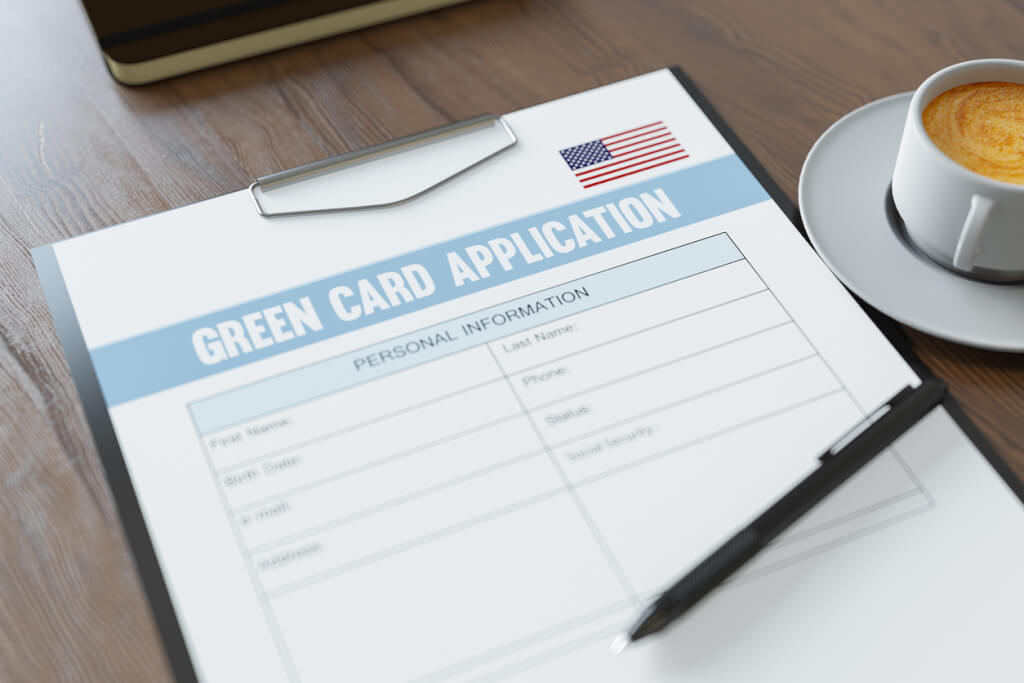How to get a green card if you are not in the USA: who is eligible and how to apply
There are two main ways to apply for a green card (U.S. permanent resident status). Foreign nationals who meet certain criteria may be eligible to apply from the United States through a process called change of status. But most foreign nationals apply from outside the United States to a US embassy or consulate. This is known as consular processing. Edition Citizen path presented an overview of the process for applying for a family immigrant visa (green card) for processing at the consulate.

Photo: IStock
Eligibility to Apply for a Green Card
Before you begin, you need to know if you are eligible to apply for a green card through family. Only certain relatives of US citizens or lawful permanent residents (current green card holders) are eligible.
Next of kin
Immediate family members for family green cards include spouse, unmarried children (under 21), and parents of US citizens. And that's it. Since an immigrant visa is always available to immediate family members, this is a special category for each case:
- IR-1: spouse of a US citizen;
- IR-2: Unmarried child of a US citizen under the age of 21;
- IR-3: Orphan adopted overseas by a US citizen;
- IR-4: Orphan adopted in the US by a US citizen;
- IR-5: Parent of a US citizen (applicant must be at least 21 years of age).
On the subject: The ten most common mistakes when applying for a green card
Priority Categories
On the other hand, family visa categories usually have long waiting times. This is because immigration law defines a limited number of immigrant visas each year. If there are more applicants for a visa than there are available visas, a waiting list is created and, as a result, the categories of the order of receipt:
- F-1 (Family First Preference): unmarried sons, unmarried daughters of a US citizen and their minor children;
- F-2 (Family Second Preference): Spouses, minor children, and unmarried sons and daughters (age 21 or older) of a lawful permanent resident;
- F-3 (Family Third Preference): married sons and daughters of a US citizen, their spouses and minor children;
- F-4 (Family Fourth Preference): U.S. citizen's siblings, spouses, and minor children (applicant must be at least 21 years of age).
Step 1: Submit Form I-130
The entire consular process begins with a US citizen or permanent resident filing a petition with the US government on behalf of a foreign relative who wants to apply for a green card.
Form I-130 Petition for Alien Relative establishes the appropriate relationship with the relative. For example, a US citizen can file a petition on behalf of their foreign spouse. This is a request to the United States Citizenship and Immigration Services (USCIS) to recognize a foreign spouse as the next of kin of a US citizen and grant an immigrant visa. Even if the applicant is outside the United States, they may file Form I-130 to begin the process.
If the I-130 petition is correctly filed with the correct supporting documents, USCIS will make a decision on the petition. For the next of kin, this decision comes quite quickly, after about 5-10 months. Depending on the specific type of relationship, categories can take anywhere from a few months to a few years.
Even when USCIS approves the I-130 petition, it doesn't mean the wait is over.
Step 2: Processing fee at the National Visa Application Center
Once USCIS approves Form I-130, the agency will forward the case to the National Visa Application Center (NVC). The NVC is part of the US Department of State and will eventually refer your case to the US Embassy or consultant who conducts the visa interview.
It may take up to a month for your case to be transferred to NVC. You will know that your case is in the NVC system when you receive a letter (via email and postal mail). NVC will also give you online access to the case.
Before the NVC starts processing your case, you must pay two separate fees:
- fee for processing an application for an immigrant visa;
- fee for affidavit of support.
Step 3: Prepare an Affidavit of Support
Almost all family immigrants must prove that they will not be a burden to the country. Therefore, they must have a financial sponsor who promises to take financial responsibility for the person who applies for a green card.
Applicant must prepare and file Form I-864, Affidavit of Support, with supporting documents. If the applicant does not meet income requirements, the joint sponsor may file Form I-864 on behalf of the intended immigrant.
By signing Form I-864, the applicant (including any co-sponsors) agrees to use their resources, if necessary, to financially support the immigrant and any dependents. If immigrants receive any prescribed federal or local welfare benefits, the benefit agency "must seek reimbursement" from the person signing Form I-864.
Step 4. Apply for a Green Card
Finally, after completing all the previous steps, your relative can apply for a green card. It is at this stage that he is entitled to complete the online visa application (DS-260).
Form DS-260 is available at State Department website. To get started, you need to know your case number.
Although you won't be able to preview the online green card application, you can preview sample application DS-260. After you submit your DS-260 application, you must print out the confirmation page and take it with you to your interview.
Step 5: Submit your documents
The application process is not really complete until you submit your civil documents. Civil documents are records made by an official document issuing authority in your country. Examples are birth certificates and marriage certificates.
The specific civil documents you need depend on your case. The NVC will inform you of the specific civil documents required to support your application. These documents may include:
- birth certificate;
- Marriage certificate;
- divorce certificate or death certificate;
- passport;
- military records;
- court and prison records;
- police certificates.
All documents written in languages other than English or in the official language of the country you are applying from must be accompanied by certified translations.
The National Visa Center strongly recommends that you scan and send all documents. You can mail these documents, but this will delay your case. Specific guidance will come from NVC.
Some documents require originals. Therefore, keep the original documents together in a folder that you can take to your visa interview.
Once you have paid all fees, filed Form DS-260, and submitted all civil documents, you have successfully applied for a green card. NVC will confirm by email that your case is "documented" complete. At this point, the NVC will begin coordinating with the US Embassy or Consulate where you will be interviewed.
Step 6: Preparing for the Immigrant Visa Interview
The NVC will schedule a visa interview at the US embassy or consulate you have designated. All parties, including the applicant and potential immigrant, will be notified by email. This is your signal to prepare.
You may be interested in: top New York news, stories of our immigrants and helpful tips about life in the Big Apple - read it all on ForumDaily New York
Before the interview, but not before the date is set, the immigrant must undergo a medical examination. The examination must be carried out by a doctor - an expert doctor approved by the embassy. Consular officials do not accept examinations conducted by other specialists. After your examination, the doctor will either send the results of the examination directly to the embassy or give you a sealed envelope. If the doctor gives you an envelope, do not open it. Take the results to your visa interview and give them to the consular officer.
Step 7: Immigrant Visa Interview
The visa application is not formally submitted until after the US consulate has conducted an interview with the immigrant visa applicant. In other words, you didn't apply for a green card until you were interviewed. If you arrive at the embassy prepared, the interview at the consulate will go very quickly.
Who attends the consular interview
As a rule, all family members who have applied for an immigrant visa must participate in the interview. This may include you, your spouse, and unmarried children who immigrate with you. The NVC letter will list all applicants required to participate.
If your spouse or children immigrate later and travel separately from you, they are not required to participate in the consular interview. They will be scheduled for a separate interview.
Your sponsor is not present at the visa interview.
What to bring to your interview at the consulate
Carefully read the letter received from NVC. It will detail the specific items you need to bring with you to your interview. The list may vary by country or embassy.
As a rule, consular officers expect you to bring with you:
- an interview appointment letter you received from NVC;
- passport;
- for each applicant, an unexpired passport valid for six months after the intended date of entry into the United States;
- photographs (submit two identical color photographs for each applicant, which must meet the State Department's photo requirements;
- form DS-260 confirmation page;
- documentation;
- originals or certified copies of all documents you submitted in step 5.
Read also on ForumDaily:
What day is better to go to the store to save a lot of money
Egg prices are rising at an unprecedented pace: in which stores you can still find them cheaper
Massage, meditation and entertainment: 6 great spa resorts in the USA
Four tax credits to save up to $8000
Subscribe to ForumDaily on Google NewsDo you want more important and interesting news about life in the USA and immigration to America? — support us donate! Also subscribe to our page Facebook. Select the “Priority in display” option and read us first. Also, don't forget to subscribe to our РєР ° РЅР ° Р »РІ Telegram and Instagram- there is a lot of interesting things there. And join thousands of readers ForumDaily New York — there you will find a lot of interesting and positive information about life in the metropolis.












